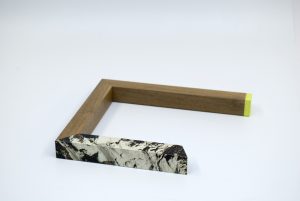
Maquette 13 by Tyler Beard
For some, framing and presenting the work is an afterthought; however, artists must consider the longevity of their works. Framing does not have to be difficult or expensive but it should always be archival. Archival framing uses only acid-free materials. Non-archival framing can be slightly less expensive in the short term, but the problems that occur over time can cost much more and irreversibly damage the work.
The risks of non-archival framing include:
- Light Damage – Glass without UV protection can cause fading, especially in sunny locales. Using UV glass will guarantee your work is protected. Display your artwork away from direct sunlight to prevent fading.
- Acid Damage – Many commercial glues contain acid which can burn or discolor the work and turn it brittle over time. Instead, use an archival or neutral pH glues and mats.
- Breakage – You want to be sure the artwork is securely fastened to the mat with archival tape or glue which can help to hold a piece in place in case of a fall. Just don’t go elbowing priceless Picassos.
- Fingerprints – Oils from handling can eventually show up on the artwork and matboard. So be careful when handling your work and use cotton gloves to avoid fingerprints.
- Mildew – Fungal or plant growth caused by poor framing can allow mildew to form, especially in humid environments like bathrooms.
It may sound like a goliath task to deal with all these problems, but you just have to look for preservation matting and framing. Look for key words like “ACID-FREE” or “NEUTRAL pH” which describes materials and methods designed to limit these issues. On a side note, most IKEA frames are packaged with acid-free mat boards. The Library of Congress has some of the best guidelines for framing and mounting, plus an easy step-by-step guide (most of us are visual learners, after all.)
Once you’ve framed the work, you’ll have to think about where you’ll hang it. Here are some areas to consider:
- Out of direct sunlight or any intense light source (UV rays come off indoor lights too); if you enjoy covering your furniture in plastic, you may consider covering the frame with a hanging cloth to block all light when the object is not being viewed, it’s your art after all.
- Away from working fireplaces or radiators. Steam, smoke and heat can all damage a piece overtime.
- Away from intake or outtake vents. Dust and mildew can develop over the artwork.
- Off exterior walls which tend to reach extreme temperature changes and bear more moisture.
- Out of attics, basements, or any other areas prone to environmental extremes and with high risk of water leaks.
- Off of the floor. Maybe you use the floor as an extended shelf, but that doesn’t work as an additional wall for artwork.